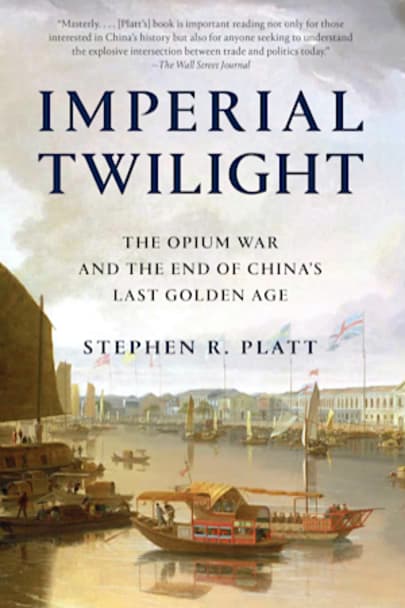As China reclaims its position as a world power, Imperial Twilight looks back to tell the story of the country’s last age of ascendance and how it came to an end in the nineteenth-century Opium War. As one of the most potent turning points in the country’s modern history, the Opium War has since come to stand for everything that today’s China seeks to put behind it. In this dramatic, epic … dramatic, epic story, award-winning historian Stephen Platt sheds new light on the early attempts by Western traders and missionaries to “open” China even as China’s imperial rulers were struggling to manage their country’s decline and Confucian scholars grappled with how to use foreign trade to China’s advantage. The book paints an enduring portrait of an immensely profitable—and mostly peaceful—meeting of civilizations that was destined to be shattered by one of the most shockingly unjust wars in the annals of imperial history. Brimming with a fascinating cast of British, Chinese, and American characters, this riveting narrative of relations between China and the West has important implications for today’s uncertain and ever-changing political climate.
more



Stephen Platt’s history Imperial Twilight dissects the causes of the First Opium War between Great Britain and the Qing Dynasty in China in the early 1840s. This book, however, does much more than just catalogue the deterioration of relations and the subsequent outbreak of war between the world’s largest, richest nation and the world’s most technologically advanced power. It also explains much about the relationship between China and the West—lessons that we can still learn from today. Platt utilizes secondary sources (it’s a topic that has been written about extensively) but he unveils fascinating pieces of history through the accounts of the colorful figures at the center of this seminal episode in history. Interestingly, several of Platt’s sources come from American traders in China at the time.
The subtitle of Platt’s work The Opium War and the End of China’s Last Golden Age is a bit deceiving since the Qing Dynasty (which was not even Han Chinese but Manchu) had been in decline for decades prior to the rise of the opium trade and the conflict with Great Britain. Platt describes the corruption, the financial problems, and the social unrest China had been experiencing by the time British traders arrived on their doorstep at the end of the 18th century. Uprisings, dynastic power struggles, and rebellions were almost as ubiquitous as famine and natural disasters. The Qing Dynasty was unpopular among educated and wealthy Han Chinese, including the large body of Hong merchants and Han civil servants, trained in the classical Confucian manner. The Qing emperor Qianlong initially rebuffed a British mission in 1793 that sought to open trade between the two nations. But the British East India Company—hungrily eyeing Chinese silks, ceramics, and tea—was not easily deterred.
Eventually the British were able to establish a small trading station on the estuary of the Pearl River next to Canton. They were joined by traders from France and the United States. British silver initially financed the trade for the goods (there were no attractive Western products for the Chinese market), but the East India Company started to run out of specie. Seeking a new product, they introduced Bengal opium from their colony in India. Opium already existed in China, but not in large amounts. Soon British imports of Bengal opium mushroomed—as did addiction in China—and the Qing Dynasty resisted. After a large cache of British opium was seized by Chinese authorities in 1839, the British sent a fleet, and a naval conflict ensued the following year. It was short, and bitter for the Chinese. In victory, Britain received Hong Kong, the ability to trade in four other Chinese treaty ports, and the Qing Dynasty was forced to pay Britain a steep indemnity.
What is fascinating (besides Platt’s great descriptions of the various characters) is the way both British and Chinese officials did everything they could to not upset the trade between the two countries, which was enriching many powerful men (sound familiar?). Fearful of losing the Chinese market, the East India Company and the British government were reluctant to respond to any Chinese threats or small-scale actions. But ultimately, after China seized British assets, they were pulled in. British trade with China prospered up until the Second World War. For decades it would be based on the opium trade. How ironic now that America’s opioid crisis is in part due to the import of cheap Chinese pills. It was also interesting to read Platt’s description of the relationship between the American trader John Murray Forbes and the shrewd Hong Merchant Houqua, who oversaw all the business of the East India Co. factory in Canton. The two would go on to share a partnership spanning decades, and would include Chinese investment in American railroads. Evidently, coolies were not the only Chinese participants building American railroads.
This book was well-written and informative, full of facts but as gripping as a novel. Recommended to anyone who wants to better understand 19th-century Britain, or where we got to where we are with China, Hong Kong and even the opioid crisis.